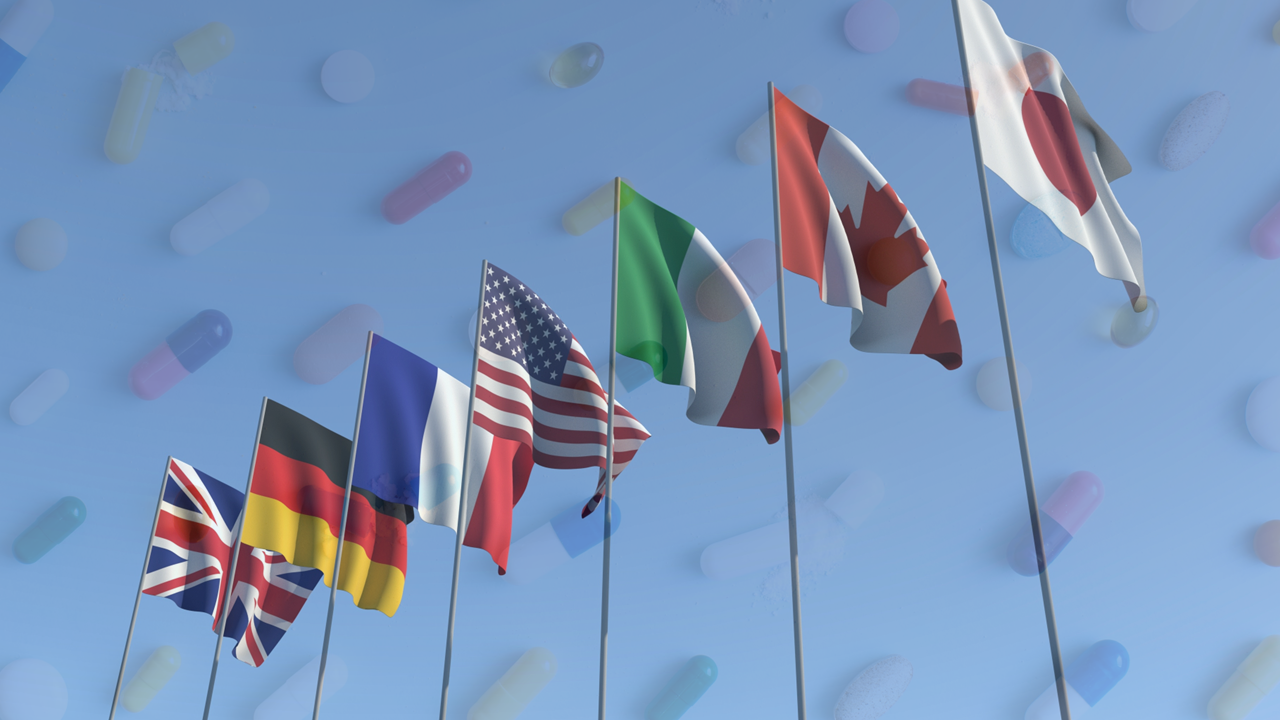Programs to incentivise antibiotic R&D are underway in the UK and under consideration in the US, EU, Canada, and Japan. We have assessed the benefits and costs to the members of the G7/EU and project that all G7/EU members would see big payoffs ranging from 11:1 in the UK to 28:1 for the US and Japan. Global returns from reducing the 1.27m people dying each year from AMR are even higher.
The world needs new antibiotics. The May G7 meeting emphasised “ supporting relevant pull incentives”. The United Kingdom (UK) has already launched a subscription purchasing model for two antibiotics and is planning a scale-up, while programs to incentivise antibiotic research and development (R&D) are under consideration in the United States (US), European Union (EU), Canada, and Japan.
A few weeks ago, we ( Adrian Towse and Rachel Silverman Bonnifield) estimated the expected return on investment (ROI) to the US government for an ambitious new program to bring 18 antibiotics to market over the next three decades, targeted at the six priority pathogens that cause the most deaths. We found that the US would pay $17.9 billion over 30 years but save 383,000 American lives with a value of $495 billion—an ROI of 28:1. We assumed that the US would pay its “fair share” of the total global incentive cost, proportionate to its GDP within the G7 + EU, i.e., 46 per cent.
We have now assessed the benefits and costs to the other members of the G7 who would be footing the rest of the bill. We project that all G7 members would see a big payoff.
G7 countries are a heterogenous group across many different dimensions, including population, GDP, health expenditure, and baseline levels of antibiotic resistance. We do our best to account for those differences in our calculations, using local data combined with data from the GRAM study whenever possible.
First, G7 members would contribute different amounts to the overall pot. We assume a total incentive of $4.5 billion is needed per drug. We split those costs among the G7 + EU members relative to each member’s 2021 GDP (Table 1).
Table 1. Fair share calculation
| GDP (trillion) | Per cent | Contribution Per New Drug (Millions USD) | |
| USA | 23.00 | 45.8% | $2,061 |
| Japan | 4.94 | 9.8% | $443 |
| United Kingdom | 3.19 | 6.4% | $286 |
| Canada | 1.99 | 4.0% | $178 |
| European Union | 17.09 | 34.0% | $1,532 |
| Total | 50.21 | 100.0% | $4,500 |
Source: World Bank Databank, using OECD data
Second, G7 members vary substantially in their willingness to pay for a disability-adjusted life year (DALY) given current health expenditure, as well as the health system costs associated with antimicrobial resistance (AMR). We use local estimates of cost-effectiveness thresholds and AMR-related health expenditure to come up with our estimates of DALY values and health system costs associated with an AMR death. We use USD (at average 2022 exchange rates) for consistency and err on the conservative side where relevant, e.g., using the lower end of a threshold range.
Table 2. Cost per DALY and hospital costs per AMR death, by G7 member
| DALY Value | Health System Costs/Death | |
| Canada | $38,600 | $200,000 |
| European Union | $50,300 | $35,100 |
| Japan | $38,200 | $69,000 |
| United Kingdom | $24,800 | $29,500 |
| United States | $100,000 | $131,000 |
Finally, G7 members have different starting points for the level of AMR deaths. We use a mix of international estimates and local data to estimate the number of deaths attributable to six priority pathogens, as well as the average number of DALYs associated with each death (Table 3).
Table 3. Baseline deaths and DALYs per death attributable to six priority pathogens, by G7 member
| Annual Deaths (6 Priority Pathogens) |
DALYs/ Death | |
| Canada | 3,500 | 20.0 |
| European Union | 28,000 | 16.8 |
| Japan | 19,600 | 13.1 |
| United Kingdom | 6,400 | 17.1 |
| United States | 27,800 | 17.0 |
| Total | 85,200 |
New antibiotics are a good investment for everyone
Despite differences among the G7, we find that an antibiotic incentive program pays off for every G7 member country. ROI in the short term (10 years) varies from 2.5:1 (for the UK) to 6:1 (for Japan and the US). ROI in the long term (30 years) varies from 11:1 (for the UK) to 28:1 (for Japan and the US). Across the G7, the program would save 61,000 lives in the next 10 years, and 1.17 billion lives over the full 30-year duration.
Table 4. Return on investment, by G7 member
| 10-Year Lives Saved | 30-Year Lives Saved | 10-Year ROI (Benefits per USD) |
30-Year ROI (Benefits per USD) |
|
| Canada | 2,500 | 48,100 | 4.5 | 20.4 |
| European Union | 20,000 | 384,900 | 3.9 | 18.2 |
| Japan | 14,100 | 269,700 | 6.0 | 27.7 |
| United Kingdom | 4,600 | 88,400 | 2.5 | 11.4 |
| United States | 20,000 | 383,000 | 5.9 | 27.6 |
| G7 Total | 61 ,300 | 1 , 174 ,100 | 5 . 0 | 23 . 1 |
The global benefits of the new drugs in tackling the 1.27m people dying each year from AMR are even higher as set out in Table 5 below.
Table 5: Global Costs and Benefits, over 10 years and over 30 years
| Total Cost (Discounted) | Lives Saved | DALYs Saved | Value of DALYs Saved | Benefit: Cost Ratio | |
| 10-Year | $11.7 bn | 518,000 | 19.5 million | 310.6 billion | 27:1 |
| 30-Year | $38.9 bn | 9,933,000 | 374.5 million | 4,874.2 billion | 125:1 |
The full details behind our estimates are available on the CGD website, including key assumptions and sensitivity analysis with individual briefs here for Canada, the EU, Japan, and the UK, plus our original paper on the US, with the supporting Excel Model also available here . The message is clear: new antibiotics are a high return investment for all G7 members—and we look forward to Japan’s leadership under its G7 Presidency to make this vision a reality.
Citation
Silverman Bonnifield R and Towse A.(2022 Estimating Canada’s Return on Investment from an Ambitious Program to Incentivize New Antibiotics. Policy Brief. Center for Global Development. Available at https://www.cgdev.org/publication/estimating-canadas-return-investment-ambitious-program-incentivize-new-antibiotics
Silverman Bonnifield R and Towse A. 2022 Estimating Japan’s Return on Investment from an Ambitious Program to Incentivize New Antibiotics. Policy Brief. Center for Global Development. Available at https://www.cgdev.org/publication/estimating-japans-return-investment-ambitious-program-incentivize-new-antibiotics
Silverman Bonnifield R and Towse A. 2022 Estimating UK’s Return on Investment from an Ambitious Program to Incentivize New Antibiotics. Policy Brief. Center for Global Development. Available at https://www.cgdev.org/publication/estimating-uks-return-investment-ambitious-program-incentivize-new-antibiotics
Silverman Bonnifield R and Towse A. 2022 Estimating EU’s Return on Investment from an Ambitious Program to Incentivize New Antibiotics. Policy Brief. Center for Global Development. Available at https://www.cgdev.org/publication/estimating-eus-return-investment-ambitious-program-incentivize-new-antibiotics
Towse, A. and Silverman Bonnifield, R. 2022. “An Ambitious USG Advanced Commitment for Subscription-Based Purchasing of Novel Antimicrobials and Its Expected Return on Investment.” CGD Policy Paper 277. Washington, DC: Center for Global Development. An Ambitious USG Advanced Commitment for Subscription-Based Purchasing of Novel Antimicrobials and Its Expected Return on Investment | Center for Global Development | Ideas to Action (cgdev.org)
Related research
OHE four-part blog series: The Economics of Antibiotics discussed the economics of antimicrobial resistance:
- Part 1: Why NICE and NHS England are Testing an Innovative HTA and Payment Model to Tackle AMR
- Part 2: Value Assessment within the NICE-NHS AMR Pilot
- Part 3: Creating a Healthy Global Market for New Antibiotics
- Part 4: What Does the Antibiotics Market of the Future Look like?
References
Mott, D.J., Hampson, G., Llewelyn, M.J. et al. A Multinational European Study of Patient Preferences for Novel Diagnostics to Manage Antimicrobial Resistance. Appl Health Econ Health Policy 18, 69–79 (2020). https://doi.org/10.1007/s40258-019-00516-0
Neri, M., Hampson, G., Henshall, C. and Towse, A., 2019. HTA and payment mechanisms for new drugs to tackle AMR. OHE Research Paper, London: Office of Health Economics. Available at: https://www.ohe.org/publications/hta-and-payment-mechanisms-new-drugs-ta…
Towse, A., Hoyle, C., Goodall, J., Hirsch, M., Mestre-Ferrandiz, J., Rex J. 2017. Time for a Change in How New Antibiotics are Reimbursed: Development of an Insurance Framework for Funding New Antibiotics based on a Policy of Risk Mitigation. Health Policy http://dx.doi.org/10.1016/j.healthpol.2017.07.011
Karlsberg Schaffer, S., West, P., Towse A., Henshall C., Mestre-Ferrandiz J., Masterton R., and Fischer, A. Assessing the Value of New Antibiotics: Additional Elements of Value for Health Technology Assessment Decisions. Office of Health Economics Research Paper, May 2017 Available at: https://www.ohe.org/news/assessing-value-new-antibiotics-additional-elements-value-health-technology-assessment
Ferraro, J., Towse, A., and Mestre-Ferrandiz J. Incentives for New Drugs to Tackle Anti-Microbial Resistance. Office of Health Economics Research Paper, May 2017. Available at: https://www.ohe.org/publications/incentives-new-drugs-tackle-anti-microbial-resistance
Towse, A. and Sharma, P. (2011) Incentives for R&D for New Antimicrobial Drugs. International Journal of the Economics of Business. 18(2), 331-350. https://doi.org/10.1080/13571516.2011.584434
Sharma, P. and Towse, A. (2011) New Drugs to Tackle Antimicrobial Resistance: Analysis of EU Policy Options. Research Monograph. London: Office of Health Economics. https://www.ohe.org/publications/new-drugs-tackle-antimicrobial-resistance-analysis-eu-policy-options
Ferraro, J., Towse, A., and Mestre-Ferrandiz J. Incentives for New Drugs to Tackle Anti-Microbial Resistance. Office of Health Economics Research Paper, May 2017. Available at: https://www.ohe.org/publications/incentives-new-drugs-tackle-anti-microbial-resistance
Towse, A. and Sharma, P. (2011) Incentives for R&D for New Antimicrobial Drugs. International Journal of the Economics of Business. 18(2), 331-350. https://doi.org/10.1080/13571516.2011.584434
Sharma, P. and Towse, A. (2011) New Drugs to Tackle Antimicrobial Resistance: Analysis of EU Policy Options. Research Monograph. London: Office of Health Economics. https://www.ohe.org/publications/new-drugs-tackle-antimicrobial-resistance-analysis-eu-policy-options


